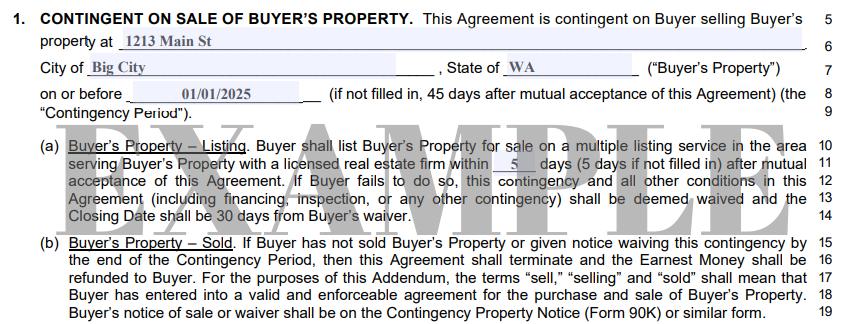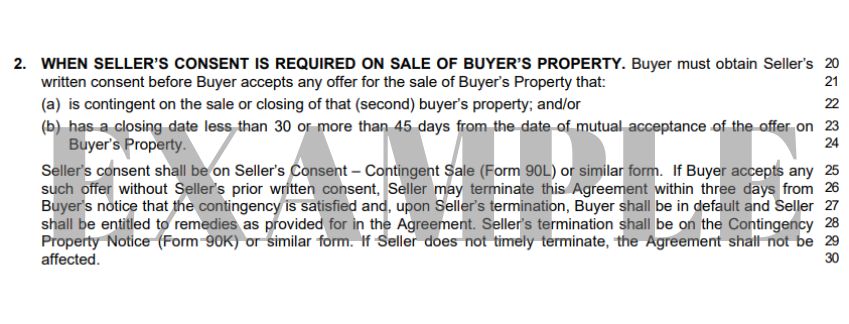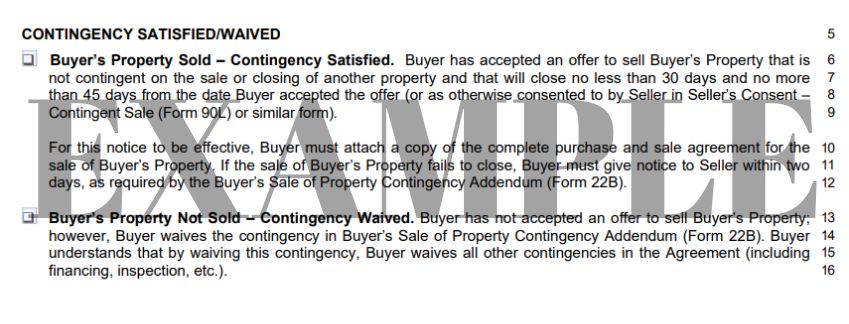Selling your home in order to purchase contingent
Buying a Home Contingent on the Sale of Your Home can be a tricky thing! It requires a good deal of cooperation and, often times, consent by the seller along the way.
It also requires a slew of additional forms and most importantly, the requirement of a full list of folks:
- You the buyers
- The sellers
- The sellers real estate professionals
- The lender
- Escrow
to all perform their jobs.
Granted, there are parts of Seattle where the real estate market is still too hot for home buyers to even consider making an offer contingent on the sale of their home. In fact, some purchase and sale agreements in the more active and sought after areas of Seattle have little if any real conditions (or contingencies) to speak of!
However, there are allways homes that end up sitting on the market longer than the seller had hoped for. When this happens, or a buyer gets lucky, than we can offer to buy the sellers home contingent on selling the buyers home.
Remember: It is allways OK to buy and sell in the same market conditions.
Sound confusing? It can be…
What is a Contingent Offer?
A Contingency is nothing more than:
A condition a buyer makes, like an inspection or financial contingency, that gives the buyer recourse to rescind (or otherwise get out of the purchase and sale agreement) in the event that condition is not met or satisfied.
For example, a home buyer who adds an inspection contingency to their offer has the right to inspect the property, including systems that service the property such as well and septic tanks and even terminate the transaction should they deem the inspection unsatisfactory.
The buyer’s ‘Sale of Property Contingency Addendum‘ (NWMLS Form 22B) to the ‘Purchase and Sale Agreement‘ (NWMLS Form 21) states that a home buyer must sell their own home in order to buy the sellers home.
Understanding Form 22B Buyers Sale of Property Contingency Video

Understanding Form 22B: The Basics
Form 22B, known as the Home Sale Contingency form, is a crucial document for buyers who need to sell their current home before buying a new one. Here’s a breakdown of what you need to know:
- Purpose: This form is used when a buyer needs the proceeds from their current home sale to purchase a new property.
- Conditions: The buyer’s offer on the new home is contingent upon selling their existing home.
- Risk: The buyer’s offer can be bumped by another offer if their current home isn’t sold within a specified timeline.
The Difference Between Forms 22B and 22Q
It’s easy to confuse Form 22B with Form 22Q, but they serve different purposes:
- Form 22Q: Used when the buyer’s current home is already under contract.
- Form 22B: Used when the buyer needs to sell their current home, which may or may not be listed yet.
Key Elements of Form 22B
Let’s walk through the important sections of Form 22B and what they mean for buyers and sellers:
- Property to be Sold:
- This section identifies the buyer’s current home that needs to be sold.
- Listing Requirement: The buyer must list their property for sale within a negotiable timeframe, defaulting to five days.
- Contingency Expiration:
- A specific date by which the buyer must have their home under contract.
- Failure to do so can lead to automatic termination of the contract, with the buyer potentially losing their earnest money.
- Financing Protection:
- Form 22B does not protect the buyer’s financing; separate contingencies like the financing contingency (Form 22A) must be included for this protection.
The Seller’s Role
Sellers can bump a contingent offer if they receive a better offer. This means:
- Active Marketing: Sellers can continue to show the home and even reduce the price to attract other buyers.
- Bump Notice: If a better offer comes in, the seller can issue a bump notice, giving the first buyer a chance to remove their contingency and proceed with the purchase.
Important Rules and Consequences
Using Form 22B comes with specific rules and potential consequences:
- Listing the Property:
- Buyers must list their home for sale within the agreed timeframe. Failure to do so results in waiving all contingencies and the buyer must close within 30 days.
- Satisfying the Contingency:
- The buyer must have an enforceable contract on their home sale. This includes all necessary approvals and a set closing date.
- Seller’s Consent:
- Certain actions require the seller’s consent, such as accepting another contingent offer or altering the closing timeline.
Filling Out Form 22B
When completing Form 22B, make sure to:
- Include Accurate Information: List the property that needs to be sold and set realistic timelines.
- Detail Contingency Expiration: Clearly define the deadline for having the property under contract.
- Follow Listing Requirements: Ensure the buyer lists their property within the agreed days.
Practical Scenarios and What to Expect
In real-life situations, it’s crucial to understand the practical implications of using Form 22B:
- Multiple Offers: If a better offer comes in, the seller can issue a bump notice. The first buyer then has a limited time to remove their contingency or risk losing the home.
- Loan Application Timing: Decide when the buyer should make their loan application, considering the entire timeline of the sale and purchase process.
- Good Faith Effort: Buyers are expected to make a genuine effort to sell their home, keeping it on the market and actively seeking buyers.
Conclusion
Buying a house contingent on selling your current home involves navigating several rules and timelines. Understanding Form 22B and its requirements can help you manage this process smoothly. Remember to:
- List your property promptly.
- Keep an eye on the deadlines.
- Communicate effectively with your agent and the seller.
This is one of the more rarely seen conditions simply because it puts the seller in a precarious position. Essentially, the home seller has to have a good deal of faith the home buyer is doing their part to make their home marketable and salable…two very important factors for any home for sale!
Why is Buying a House Contingent on Sale of Your Current Home even Necessary?
The most common reason for a buyer to enter into a purchase contingent on the sale of their home is a financial need!
Simply put, some buyers can not get a second home loan if they currently have an existing mortgage.
It take Two to Tango
REMEMBER: The seller does not need to accept your offer if it is contingent on the sale of the buyer’s property.
Steps to Buying a Home Contingent on Sale of Your Current Home
Step 1. Get your offer accepted
This may sound like a ‘no-brainer’ but remember, not every seller is going to be interested in taking a contingent offer. On top of that, Your real estate professional will have to be well versed in the language of the contingency agreement.
Equally important, your real estate broker is more than likely going to need to negotiate with the sellers broker to convince them to consider the buyers offer contingent on the sale of their home.
There’s quite a few moving parts here, finding the right real estate professional who knows how contingencies work is vital.
Step 2. Getting your Home ready to Go to Market
The first (of many) timelines is listing your home. Per the language of the contingency, you have 5 days after mutual acceptance of the agreement to list your property for sale on a multiple listing service (MLS) in the area serving the property with a licensed real estate firm.
This could be a bit tricky if you have some ‘Honey Do’ items or repairs to do before you’re ready to list.
The Madrona Group Team has a 167 multi-point Listing checklist of items to get your home to market including:
Photography and Staging
- Order photos, 3D virtual tour, and aerials.
- Schedule an interior design consultation with a stager.
- Schedule contractors for necessary repairs and market readiness.
- Order the sign and flyer holder.
Material Creation
- Create and order just listed postcards (100).
- Order flyer box flyers (50) and “early entry” door hangers (50).
- Create a YouTube video.
Online Presence
- Input the listing on MLS.
- Create property sites on Sierra and TheMadronaGroup.com.
- Add Matterport and YouTube video links to MLS.
Promotional Activities
- Schedule and prepare for open house events.
- Advertise on social media platforms (Facebook, Twitter, Instagram, LinkedIn, Google My Business, Pinterest).
- Boost the new listing online.
- Create and run a YouTube video ad.
- Email new listing information to your sphere and other contacts.
Getting all that needs to be done to give our sellers the utmost exposure would be quite a logistical challenge in just 5 days. Although we have done it.
NOTE: Failure to list the buyers home in the 5 day time period can put them in a dire position essentially waiving the home contingency and all other contingencies including inspection and financial. The buyer would also be required to close in 30 days on top of everything else.
Being prepared to list your property should be a conversation you have with your real estate professional well before you make any contingent offer.
Step 2.5 What to do if the Seller gets an offer after they accepted your Contingent Offer?
This could happen and the buyer should understand their options in this scenario.
One of the conditions for the sellers accepting your contingent offer is they may keep their property on the market.
It does show in the status as ‘Contingent’ rather than ‘Active’ but that means very little to any prospective buyer interested in the property.
Here is the procedure when that takes place…stay with me now, this may get a little confusing
First off, the seller must send the buyer a ‘BUMP NOTICE‘ (NWMLS Form 44). This form serves as notice to the buyer that the seller has entered into a ‘Purchase and Sale Agreement‘ with another buyer.
The buyer now has 3 options. These options are outlined in the ‘BUMP REPLY‘ (NWMLS Form 46).
- Buyer sells their property and the contingency is satisfied.
- This of course would require the buyer accepting an offer to sell their home and that offer is not itself contingent on the sale or closing of another property! Still with me? Invoking this option would also require the buyer attaching the completed ‘Purchase and Sale Agreement‘. Needless to say, this is an option only to be used in the event buyer enters into a purchase and sale agreement for their home.
- Buyer did not sell their property but waives the contingency.
- This is a rather risky option to take as the buyer would be risking their earnest money if they do not sell their property in the specified timeline set forth in the ‘Buyers Property Contingency Addendum‘ (NWMLS Form 22B). Choosing this option also waives all other contingencies such as Inspection and Financial. This all but assures forfeiture of the Earnest Money should the deal fail to close.
- Buyer’s property not sold and agreement terminated.
- This is the most pragmatic choice for the buyer as they retain their earnest money and simply walk away.
Step 3. You Got an Offer on your Home…NOW WHAT?

Before you can get mutual acceptance on that offer, the seller has a few things to say about it. Well, they really only need to give the buyer written consent on the offer for the following:
- The buyers themselves are also contingent on the sale of their property
- The closing date is less than 30 days or more than 45 days
NOTE: Not getting sellers written consent if either of these conditions apply means the transaction is terminated and the Earnest Money is forfeited to the sellers.
If neither item 1 or 2 are a part of the offer on the buyers house, we are now on to giving the sellers notice we’ve received an offer.
Step 4. Waiving and Satisfying the Contingency
When the buyer has reached this point, there’s really only the matter of satisfying the ‘Buyers Property Contingency Addendum‘ and proceeding with the ‘Purchase and Sale Agreement‘ on the property.
The buyer must now give notice on ‘CONTINGENCY PROPERTY NOTICE‘ (NWMLS Form 90K) by checking the first box. Yep, another form.

This form is also the same one the buyer would use in the event the purchase and sale of their home failed to close. See check box 2 above.
Final Thoughts
Buying a house contingent on selling your current home can feel like a complex puzzle, but with the right preparation and support, it becomes entirely manageable. Understanding the key forms involved is crucial to navigating this process smoothly.
The Home Sale Contingency form (Form 22B) is essential. This form explicitly states that your purchase of a new home depends on selling your current one. It’s your safety net, ensuring you’re not stuck with two mortgages or forced into a rushed sale at a lower price.
Next, there’s the bump notice (Form 44). If the seller receives a better offer, they can issue this notice, giving you a limited time to either remove your contingency or step aside. It’s a bit of a pressure cooker, but knowing it’s part of the process helps you prepare and act swiftly.
The bump reply (Form 46) is your response to a bump notice. You can confirm your property is sold, waive the contingency (a risky move), or terminate the agreement and keep your earnest money.
Another important document is the Contingency Property Notice (Form 90K). This form is used when the buyer has satisfied or waived the sale contingency. It’s a key step in confirming that the buyer has either sold their property or decided to proceed without the contingency, ensuring that all parties are informed and the transaction can move forward.
Having a knowledgeable real estate professional by your side makes all the difference. They will guide you through each form, deadline, and requirement, ensuring everything is handled smoothly and efficiently. With clear communication and proactive planning, you can navigate the contingent sale process and move into your dream home without unnecessary stress.
Ready to make your move? Contact us today for expert guidance and support throughout your real estate journey. Let’s make your transition as seamless and stress-free as possible!
Share this post!


2 Comments on “Buying a Home Contingent on the Sale of Your Current Home”
Buying a home contingent on the sale of your current home requires careful planning, communication, and flexibility. By understanding the process and being prepared for any challenges that may arise, you can successfully navigate this complex process and achieve your goal of buying a new home.
Great tips! I hadn’t considered all the factors involved in making an offer contingent on the sale of my current home. The part about timelines and communication with my agent is especially helpful. Thanks for sharing your insights!